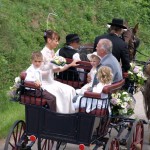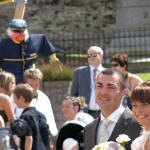To download a printable Adobe Acrobat version click on this link E2EYear7Weeks6-12.pdf
You can click on the photos to see larger versions
It was a perfect sunny afternoon after a week of muggy heat punctuated by thunderstorms. Under the trees next door, two immaculately groomed horses waited patiently with their calèche, as cars hurtled up the road and parked along the edge of our field. It was Cécile and Cédric’s wedding day. We scanned the guests from our attic window, as we were uncertain of French dress code, and promptly changed out of our colourful summery clothes into more formal black and white.  As the calèche set out we dashed downstairs, John to take photos from the first floor window and me to wave. It was an idyllic picture: the calèche driver and his boy in black suits and slouch hats, the cart horses with their mauve and cream posies, Cécile in an elegant white sheath dress and their little daughter in a matching dress and sun hat, her sister Carole’s two children and papa Gerard (who’d changed out of his shorts and T-shirt into a suave dove-grey suit). The cars turned and followed slowly behind, hooting, as is the custom, and we joined the rear of the procession down our road to the village centre.
As the calèche set out we dashed downstairs, John to take photos from the first floor window and me to wave. It was an idyllic picture: the calèche driver and his boy in black suits and slouch hats, the cart horses with their mauve and cream posies, Cécile in an elegant white sheath dress and their little daughter in a matching dress and sun hat, her sister Carole’s two children and papa Gerard (who’d changed out of his shorts and T-shirt into a suave dove-grey suit). The cars turned and followed slowly behind, hooting, as is the custom, and we joined the rear of the procession down our road to the village centre.
The first ceremony, the obligatory legal one, was held in the mayor’s parlour with family and close friends.  Parked prominently outside was Cédric’s old white van, with a life size dummy suspended from gallows on the back. We were amused to see that it was dressed in a blue and yellow post office uniform, and held together with post office tape, Cédric being an employee of la Poste. The hanged man traditionally represents the end of the groom’s life of freedom.
Parked prominently outside was Cédric’s old white van, with a life size dummy suspended from gallows on the back. We were amused to see that it was dressed in a blue and yellow post office uniform, and held together with post office tape, Cédric being an employee of la Poste. The hanged man traditionally represents the end of the groom’s life of freedom.
Through the open windows we could hear Farmer Duhaut (who is also one of our two deputy mayors) reciting the obligatory clauses of the constitution relating to marriage duties and obligations. The civil ceremony completed, it was only a short step up past the war memorial and into the village church for the (optional) mass.
The Entre-deux-Eaux church is now only used for four sparsely attended services a year, plus funerals and weddings. So it was good to see it well-maintained inside and packed. The older members looked a bit shocked as the three professional singers from Alsace launched into rhythmical gospel songs (in impeccable English), with everyone clapping and swaying in time, followed by applause. We were amused that the song after they’d exchanged their wedding vows was “Let my people go!” as it was a bit late for a bid for freedom.  Sadly, few of the congregation could have been in a state of grace, including us, for only a handful of old ladies responded to the invitation to altar so the priest had a lot of wine to finish off before he could conclude the service. As the couple came out of the church, ephemeral rainbow bubbles were blown, rice was tossed (noisier than confetti), and a lot more photos were taken.
Sadly, few of the congregation could have been in a state of grace, including us, for only a handful of old ladies responded to the invitation to altar so the priest had a lot of wine to finish off before he could conclude the service. As the couple came out of the church, ephemeral rainbow bubbles were blown, rice was tossed (noisier than confetti), and a lot more photos were taken.
The vin d’honneur (with accompanying nibbles) was held on St Léonard, four and a half kilometres from here, so the horses set off with the bride, groom and small children in the calèche, and a long procession of cars followed slowly behind, more hooting. It was all very picturesque, thanks to the sunshine. And fortunately we didn’t meet any cars coming in the other direction along the narrowest stretch of the route. The tables were decorated with buttercup yellow cloths, and spread with delicacies and slim glasses of sweet wine. Large cottage loaves had been scooped out and filled with sandwiches, and more warm tasty canapés and patisseries were brought round as people chatted. Our drive home was faster than our drive there! But at some stage the family and friends would have returned, hooting, to the village hall at Entre-deux-Eaux for the wedding feast and dancing.
Traditionally the bride and bridegroom slip away from the festivities, but their friends go in search of them, bearing champagne or wine and hammer on the door and bang dustbin lids until the groom is forced to get up and invite them in. When Cécile’s sister Carole got married, some of the inebriated wedding guests stopped one house early and banged with great urgency on our farmhouse door. We weren’t there, and our visitors were very bewildered when they opened the door to these revellers who refused to go away. The fact that the “bride” had turned into a different woman, and was suddenly eight months pregnant seemed to make no difference to their clamour! However, this time, we slept soundly through it all the nocturnal comings and goings.
Our road hasn’t seen so many cars up and down it since the annual gros objets collection. Now our mayor’s aim is for no one in the commune to produce any rubbish which can’t be personally burned, composted, buried or recycled via the paper and glass bins outside the village shop. For if everyone was efficient, as in the old days, it would save the commune any rubbish collection fees. However most people manage to produce at least one full plastic bag each week, though Mme Laine would always win our road’s prize for the smallest bag. And there are always those categories of rubbish that the dustmen won’t take. So once a year there is the special collection.
We’d cleared a few things from the storage section of the attic when laying traps for and clearing up after Fluffy the fouine. So the day before the collection, John put out a cumbersome reclining long-unused TV aerial. Then as the collection coincided with his desire to re-organise his workshop atelier, he started clearing and putting out boxes of old nails and rusty files, tractor tyres, a tangle of ancient electrical switches and wires from our predecessor, the village electrician, and, after some debate, some of the small-holding’s historical items like the heavy chains for the oxen. Whilst doing so he noticed the steady drive-past of assorted vans and lorries, all appraising the scrap. Some asked permission to pick over what they saw, and others just took what they fancied.
One battered white lorry had already taken parts of the old cars that Ludo, the Laines’ grandson, had been gutting for his illicit car repair business (which I hasten to add has been recently registered and legitimised). So John took the two men (one small dark and plump in dungarees, and the other younger and presumably his son) round the back and showed them the heavy metal axle under the hazel tree. They agreed to come back the next day for it, as they hadn’t room at present. I was a little worried by the way the younger of the two kept eyeing up the old tractor. Not for disposal, I repeated firmly. All afternoon the cars and trailers cruised past. More people must have rummaged after dark, as by morning, we had only one small box remaining for the official collectors. The white lorry duly returned (loaded with more of Ludo’s car bodies), and the younger man looked wistfully at the tractor again, before doing most of the sawing up and loading of the axle. When I referred afterwards to the two men, John looked surprised. “The older one was a woman.”
From time to time we need to take either Bluto or Snowy over to Epinal to be serviced, and usually take advantage of the expedition to go to BricoDepot (the cheapest of the DIY warehouses), the Ducs de Lorraine restaurant, and an exhibition. This time we also inspected Nicola and John’s boat, which is temporarily moored there on its journey from Holland to the Aude where they now live, and, after a leisurely lunch, we went into the tourist office for a town plan (as we haven’t quite linked up different parts of the town). By chance a town tour was about to set out and the guide was able to answer a couple of points which had cropped up during my researches into Indian soldiers in the area in the last war. No, he didn’t know where the liberating Americans were quartered, but he did know the location of the old POW camp. I’d read that a large number of captured Indian soldiers had been held there by the Germans until the camp was accidentally bombed by the Americans on 11th May 1944, leaving 64 casualties. Others had escaped and roamed the countryside until reaching safety or being rounded up by the advancing allies a few months later. He showed me on our newly acquired map the site of the barracks where they’d been held, and then asked if I’d like to know where they were buried. John is becoming resigned to being dragged round and photographing graveyards, so, as there were no exhibitions of interest, we spent the next hour in the municipal cemetery on the outskirts of Epinal.
Epinal is the capital of our département, so you would think its cemetery would be large and well tended. It was certainly large, but on that hot dusty day it had a run-down and disorganised air. The guide had said that the war graves were at the back, so we walked right up to the end wall and along the top, finding only the normal monumental family graves and a disreputable area with rusting lids which looked like mass paupers’ graves. We walked back down and found a separated walled Jewish area at the bottom. Going through another wall there was an area of French war graves, with their cement crosses, which John deduced were support staff from the local garrisons. But the whole place seemed deserted, with no one to ask. Finally I found a discreet green gate in a hedge, with a path which wound through bushes and behind a gardeners’ building to an immaculately mown area with neat rows of crosses of French soldiers. Then right at the end under the shade of tall trees, was a line of elegantly sculpted Commonwealth War Graves headstones commemorating Sikhs, Hindus, Muslims and a Christian; cooks, sweepers and a water carrier, as well as frontline fighters. And there were three from the regiment I was particularly interested in, King George V’s own Bengal Sappers and Miners. I had to shout over the high wall to guide John from the garrison graves to this very secret enclosure. We realised later, that if the tricoleur had not been drooping limply in the heat between the trees, we might have located the area sooner.
The Sunday flea markets continue as usual, with occasional ones on other festive days. One of our favourite ones was on Bastille Day, July 14th at Ban-de-Laveline. It always has a few special touches, like a local history stall, the fire station’s ancient fire-fighting equipment on display, and a brass band. Although we haven’t bought much this year (there’s a limit to the amount of bric-a-brac we can house), I was delighted to find a framed print of “The Muses” by Nabis painter Maurice Denis. It was an advertisement for the Musée d’Orsay, which we’d really enjoyed on our Paris trip a few years ago. So now if you come to stay, you will be greeted in the farmhouse hallway by no lesser personages than the muses. That evening, the weather was uncertain, so we didn’t go to any of the firework displays. But late on the sky was suddenly illuminated, and from the attic window we got a perfect view of St Leonard’s fireworks rising and cascading – the same window from which, at the beginning of this newsletter, we were watching Cécile’s wedding cortège organising itself.
And thinking of weddings reminded me that this weekend must have been our wedding anniversary, though as usual it had slipped our minds. At John’s 60th birthday party it was suggested that we ought to repeat the house party in a couple of years. We haven’t quite got round to organising that … but how about a house party at the beginning of August next year? We could start a trend for 35th anniversaries! Are you free then? Or does May or October appeal more? Let us know your thoughts.
Au revoir!

